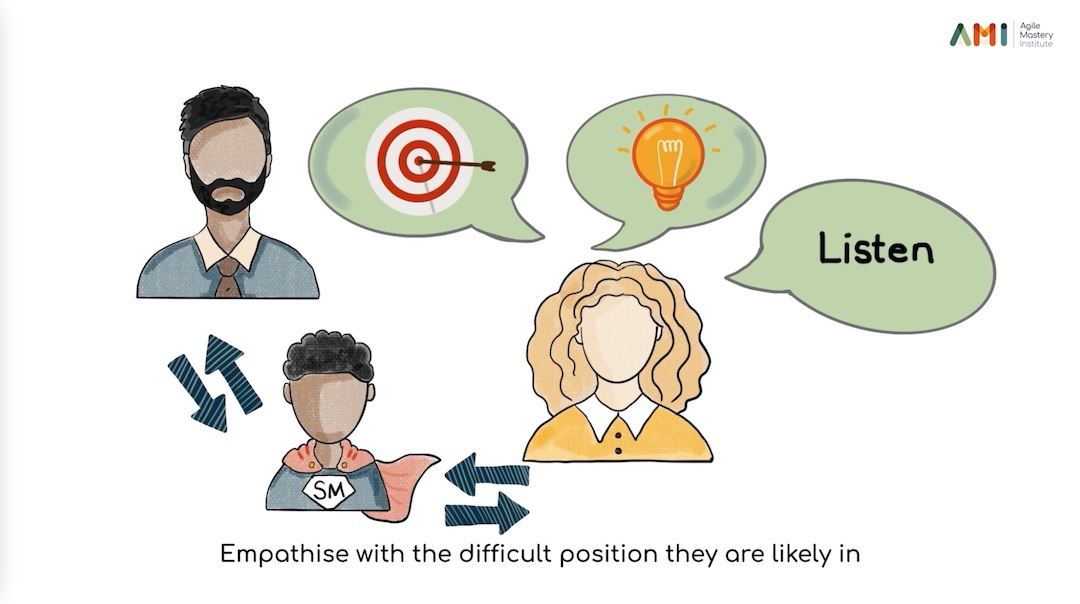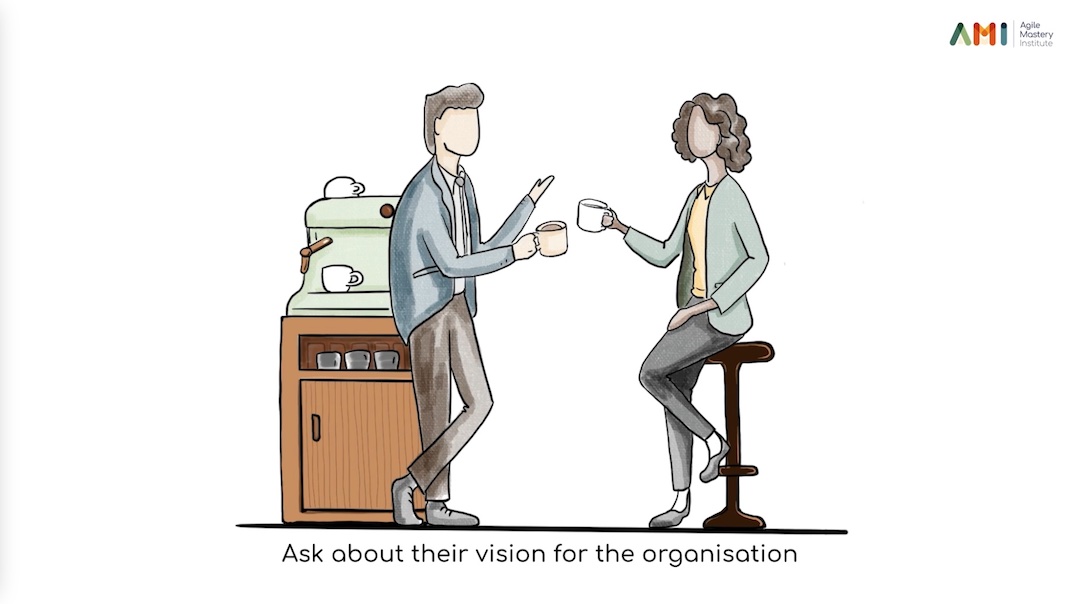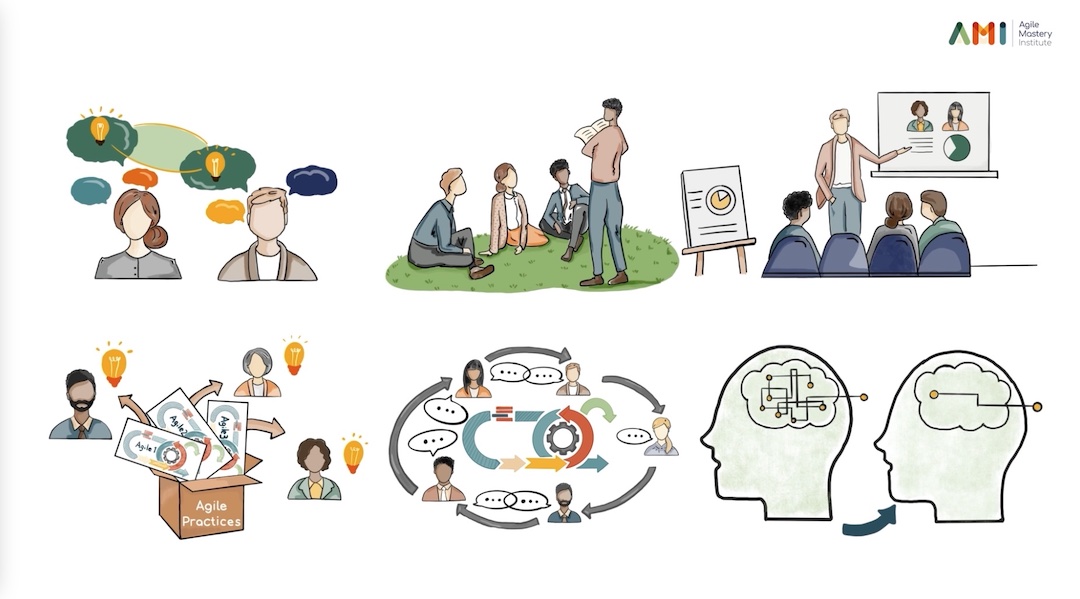5 Steps to Influence Leadership In Change
Posted By - Geoff Watts

5 Steps for Scrum Masters to Influence Leadership in Cultural Change
You’re a Scrum Master and you want to influence the culture of the organisation. This will undoubtedly require you to influence leadership to support or champion different ways of working and cultural change. This is a tricky challenge for Scrum Masters and you won’t find these skills in any standard Scrum Master courses.
In this post I’m going to share some simple techniques from our Scrum Mastery Pathway that will help you influence leadership towards supporting a more agile culture throughout the organisation from wherever you are in the organisation.
If you would prefer to watch this post instead of read it, here’s the video
You’re going to need to follow these 5 steps:
- Identify The Influential Leadership
- Build relationships with those people
- Align agile approaches to strategic organisational
- Align agile approaches to the personal goals of those influential people
- Add a little bit of behavioural science to your influencing
Identify the Influential Leaders
Understanding the real decision-making power and influence within an organisation is crucial for effectively navigating its dynamics. An obvious place to start is the formal organisational hierarchy, including reporting lines and departmental divisions. While the official structure may not reveal all the sources of power, it can provide an initial understanding of key decision-makers and their areas of responsibility. But there are a lot more nuances to influence and power within an organisation.
As well as the formal areas of power and influence, informal networks play a significant role in decision-making and influence. Look for cross-departmental connections, friendships, and alliances that extend beyond formal reporting lines. These connections can provide valuable insights into the flow of information and influence within the organisation.
Pay attention to how information is shared and who is involved in important conversations. Identify the people who are frequently consulted, whose opinions are sought after, and who can sway discussions. This can help you pinpoint influential individuals who may not hold formal authority. Influencers and opinion leaders can significantly impact decision-making, even without formal authority. They may be subject matter experts, highly respected employees, or charismatic individuals with strong interpersonal skills. Identifying these influencers can help you understand where the real power lies.

Analyse the outcomes of previous decisions and projects, and identify who was involved in the decision-making process. Look for patterns in decision-making and recurring individuals who consistently drive or influence outcomes.
Talk to colleagues who have been with the organisation for a longer time. They may have valuable insights into the power dynamics and influential individuals within the organisation. Be sure to approach these conversations discreetly and professionally.
Take note of who receives recognition and rewards within the organisation, both formal and informal. This can provide clues about the individuals who hold power and influence, as well as the values that drive decision-making.
Attend company events, social gatherings, and other informal settings where you can observe interactions between colleagues and leaders. This can help you understand the relationships and dynamics that influence decision-making within the organisation.
By employing these techniques, you can gain a better understanding of the real decision-making power and influence within your organisation. This knowledge can help you navigate the organisational landscape more effectively and build relationships with key stakeholders to support your initiatives and goals.
Build Relationships with the Influential Leaders
It’s all too easy to look at those in positions of power as people who are disconnected from the day-to-day, indeed it’s easy to perceive them as people who make life harder with their opaque decisions, shifting strategies and changing priorities. In reality, I haven’t met many leaders who deliberately want their people to suffer or fail and indeed they have their own challenges that we may not be aware of.

Build relationships with them by empathising with the difficult position that they are likely facing, such as market-driven targets and the fear of losing face when adopting a new way of working, showing genuine curiosity about their challenges, and ask open-ended questions to gain their perspective. Through active listening, you’ll gain valuable insights to help them see the benefits of agile methods. This understanding will pave the way for a stronger, more collaborative relationship between you, the Scrum Master, and the leadership.
Building relationships with senior leaders can be challenging, especially when you don’t interact with them daily. Here are some specific techniques Scrum Masters can use to establish connections and foster relationships with these individuals:
Try leveraging internal networking events to interact with leaders in a more casual setting, allowing you to introduce yourself and initiate conversations. Reach out to them and express your interest in learning from their experiences or understanding their perspectives. Schedule a brief, informal meeting or a coffee chat to discuss shared interests or learn about their vision for the organisation.
You could identify senior leaders who share your passion for agile methodologies and consider asking them to be your mentor or sponsor. This relationship can provide valuable insights, guidance, and advocacy in promoting agile practices within the organisation.

Create awareness about the benefits of agile approaches by sharing your team’s achievements, lessons learned, and agile best practices through internal communication channels, such as newsletters or intranet platforms and perhaps volunteer to give presentations at leadership meetings. This not only allows you to share valuable information but also establishes you as a subject matter expert and provides an opportunity for direct interaction with senior leaders. Also, if you can attribute success to leadership rather than yourself you increase your chances of further support in the future.
Access to the movers and shakers might be difficult so form strong relationships with anyone who works closely with those with influence and power and be patient and persistent.
Building relationships with senior leaders takes time. Continue to showcase your expertise, share your successes, and seek opportunities to engage with them.
Remember, genuine connections are built on mutual respect and shared interests. By employing these techniques and staying authentic, Scrum Masters can foster meaningful relationships with senior leaders and further promote agile practices within the organization.
Build Trust in Agile
Anything new is immediately instinctively suspicious. Remember those senior leaders have achieved significant success in their careers, often from adopting very different ways of working. Now some of them might realise that what got them here isn’t going to get them “there” but others will be almost addicted to their successful ways of working from the past.
To help people out of that, building trust in agile ways of working is crucial. Avoid coming across as overly zealous; instead, focus on how agile approaches can help the organisation succeed. Understand the organisation’s strategy and create opportunities to experiment with agile methods.
The good news is that agile approaches have something to offer almost any senior leaders personal and professional goals as well as organisational strategy. The key is positioning agile approaches to those goals.
Organisational Strategy Alignment
When building trust in agile, it’s essential to select the right metrics and visualise the impact of agile experiments. Avoid output metrics like team velocity, and instead, focus on strategic outcome metrics such as value delivery, reducing cost of delay, and measuring learning and customer satisfaction.

By incorporating these metrics into agile experiments, you can demonstrate the value of agile approaches to senior leadership. Do your research and find out what sort of metrics are important to the strategic goals of the organisation and align with those. Here are a few strategic metrics that can be positively impacted by agile practices:
Time-to-market:
This metric measures the time taken from project initiation to product launch. Start gathering data on how quickly we can gather feedback, deliver value and deploy new ideas using agile approaches.
Customer satisfaction:
Because agile approaches focus on delivering value to the customer and incorporating their feedback throughout the development process. Measuring customer satisfaction can show how agile approaches lead to better alignment with customer needs and higher overall satisfaction.
Return on Investment (ROI):
Track the financial return on projects completed using agile methodologies. By showcasing the higher ROI from agile projects, you can demonstrate the value of agile practices in terms of resource efficiency and project success. This can be a lagging indicator so try looking at this on a sprint by sprint basis first.
Cost of delay:
Agile methodologies aim to minimise the cost of delay by delivering value incrementally and adjusting priorities based on customer feedback. Measuring the cost of delay for agile projects compared to traditional projects can show the financial benefits of adopting agile practices.
Employee engagement and satisfaction:
Agile methodologies foster a collaborative and supportive work environment, which can lead to increased employee engagement and satisfaction. By tracking these metrics, you can demonstrate the positive impact of agile practices on team morale and productivity.
Innovation rate:
Agile approaches encourage experimentation and learning, which can lead to increased innovation. Measuring the number of new ideas, features, or products introduced can showcase the value of agile methodologies in driving innovation and staying competitive in the market.
Quality metrics:
Measure the quality of products or features delivered through agile projects by tracking metrics such as defect rates, user-reported issues, or system stability. Improved quality can be attributed to agile practices like continuous integration, testing, and feedback loops.
By incorporating these strategic metrics into your agile experiments and showcasing their positive impact, you can help senior leadership recognise the potential value of agile approaches and encourage their adoption throughout the organisation.
Presenting leaders with clear, visual representations of these metrics will help them see the benefits of agile approaches and make data-driven decisions. Encourage leaders to share these metrics with their teams and stakeholders, promoting transparency and accountability.
Influence Leadership Values and Drivers
Senior leaders all have personal goals and drivers that can align with and be amplified by supporting a more agile culture. If you can identify these goals and drivers (often from viewing the things they get passionate about or have operational responsibility for), then you can connect them to agile principles to give them a real personal reason for championing agility:

Legacy and impact:
Senior leaders often aspire to leave a lasting positive impact on the organisation. By promoting agile practices, they can foster a culture of continuous improvement, innovation, and adaptability, which can contribute to the organisation’s long-term success.
Personal growth and learning:
Leaders who value personal development can benefit from adopting agile methodologies, which emphasise learning, experimentation, and adaptability. By supporting agile practices, they can demonstrate their commitment to continuous learning and growth.
Empowering others:
Leaders who aim to empower their teams can achieve this goal by embracing agile principles, which emphasise decentralisation of decision-making, self-organisation, and cross-functional collaboration. This empowers team members to take ownership of their work, leading to higher engagement and motivation.
Customer-centricity:
Leaders who are driven by delivering value to customers can align their goals with agile practices, which prioritise customer feedback and adapt quickly to changing customer needs. By supporting agile methodologies, they can demonstrate their commitment to creating customer-focused products and services.
Business resilience:
Leaders concerned with the organisation’s ability to adapt and thrive in a rapidly changing business environment can benefit from promoting agile culture. Agile practices enable organisations to respond quickly to market changes, seize opportunities, and mitigate risks.
By understanding and appealing to each leader’s personal goals and drivers, Scrum Masters can help senior leaders become the leader they aspire to be by supporting and championing agile ways of working.
Influence Leadership with Behavioural Science
To minimise resistance, understand how people make decisions and what influences them. I’ve gathered a bunch of psychological factors that can help you influence and persuade people in my Persuasion Pack but as a quick starter, consider these influencing techniques:

Build rapport through sameness:
We tend to like people who are like us so increase your likeability by amplifying the areas and values you have in common.
Leverage the power of storytelling:
The human brain is hardwired to respond to stories. Sharing compelling stories about the success of agile initiatives can engage listeners emotionally, making them more receptive to your message. Use vivid examples and narratives to demonstrate the benefits of agile practices.
Use social proof:
Our brains are wired to follow the behaviours of others, especially when we are unsure of what to do. Share examples of other successful organisations or industry leaders who have adopted agile practices, emphasising the positive outcomes they have achieved. Check this out for more details.
Offer choices and autonomy:
People are more likely to support initiatives when they feel they have a sense of choice and control. Present multiple options or approaches for adopting agile practices, allowing leaders to select the ones they find most appealing or suitable for their organisation.
Use repetition and reinforcement:
The brain needs repetition and reinforcement to learn and adopt new behaviors. Regularly communicate the benefits of agile practices and share success stories to keep the message fresh and top-of-mind.
Simplify complex information:
The brain is more likely to engage with and remember information that is easy to understand. Break down complex concepts into simple, digestible messages, and use visual aids, analogies, or metaphors to convey your ideas.
By incorporating these behavioural science-based influencing tactics, you can effectively influence leadership to support and champion agile-related initiatives within the organisation.
Summary of How to Influence Leadership for Change
By building relationships with influential leaders, fostering trust in agile methods, aligning with the strategic goals of the organisation and leaders’ values and drivers using influencing techniques from behavioural science, Scrum Masters can encourage cultural change at higher leadership levels for greater agility.
Remember, as a Scrum Master, your role is vital in promoting agile ways of working and fostering a more agile culture. Sure, it won’t happen overnight and often the seeds you plant will not take root until much later, even after you have left that organisation but that shouldn’t stop you from taking whatever steps you can right now. Good luck!






